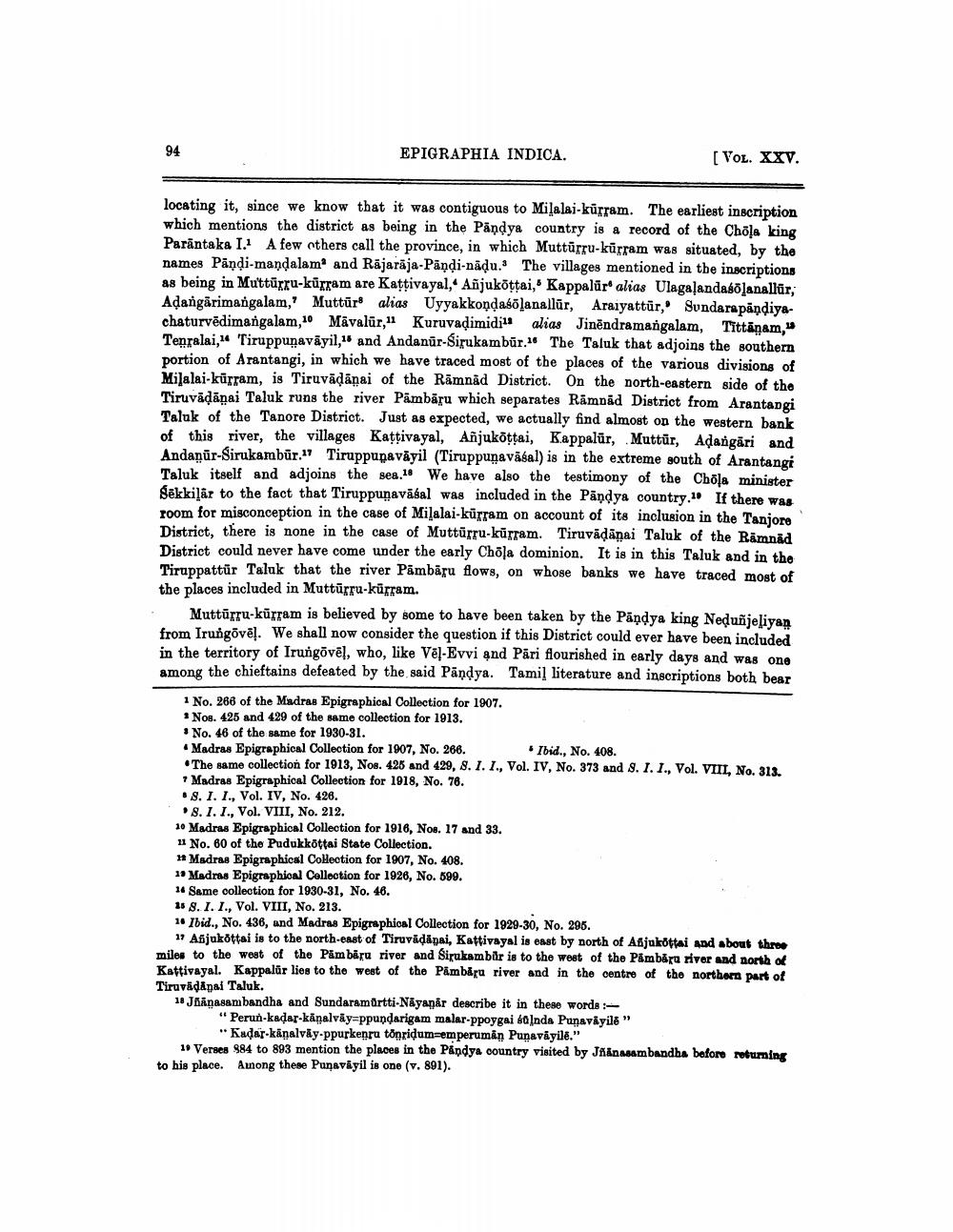________________
EPIGRAPHIA INDICA.
[VOL. XXV.
locating it, since we know that it was contiguous to Milalai-kūrram. The earliest inscription which mentions the district as being in the Pandya country is a record of the Chöļa king Parantaka 1.1 A few others call the province, in which Muttūrru-kūrram was situated, by the names Pāndi-mandalam and Rājarāja-Pāņdi-nādu. The villages mentioned in the inscriptions as being in Mu'ttūrru-kurram are Kattivayal,- Añjukottai, Kappalūra alias Ulagalandabojanallar, Adangirimangalam. Muttür alias Uyyakkondasolanallūr, Araiyattūr, Sundarapandiyachaturvēdimangalam, Māvalur," Kuruvadimidi" alias Jinēndramangalam, Tittäņam, Tenralai, 14 'Tiruppunavāyil,15 and Andanūr-Sirukambūr.The Taluk that adjoins the southern portion of Arantangi, in which we have traced most of the places of the various divisions of Milalai-kürram, is Tiruvādāņai of the Rämnad District. On the north-eastern side of the Tiruvādāņai Taluk runs the river Pāmbāru which separates Rämnad District from Arantangi Taluk of the Tanore District. Just as expected, we actually find almost on the western bank of this river, the villages Kattivayal, Añjukottai, Kappalūr, Muttūr, Adangari and Andanūr-Sirukambūr." Tiruppupavāyil (Tiruppuņavāśal) is in the extreme south of Arantangi Taluk itself and adjoins the sea.18 We have also the testimony of the Chola minister Sēkkilar to the fact that Tiruppunavāsal was included in the Pāņdya country. If there was room for misconception in the case of Milalai-kūgram on account of its inclusion in the Tanjore District, there is none in the case of Muttūrru-kurram. Tiruvādāņai Taluk of the Rämnād District could never have come under the early Chola dominion. It is in this Taluk and in the Tiruppattür Taluk that the river Pambaru flows, on whose banks we have traced most of the places included in Muttūrru-kurram.
Muttūrfu-kurram is believed by some to have been taken by the Pāņdya king Neduñjeliyan from Irungovēl. We shall now consider the question if this District could ever have been included in the territory of Irungovēl, who, like Vēl-Evvi and Pāri flourished in early days and was one among the chieftains defeated by the said Pāndya. Tamil literature and inscriptions both bear
1 No. 266 of the Madras Epigraphical Collection for 1907. - Nos. 425 and 429 of the same collection for 1913. * No. 46 of the same for 1930-31. • Madras Epigraphical Collection for 1907, No. 266.
Ibid., No. 408. The same collection for 1913, Nos. 425 and 429, 8. 1. 1., Vol. IV, No. 373 and 8. 1. 1., Vol. VIII, No. 313. Madras Epigraphical Collection for 1918, No. 78. .8. 1. I., Vol. IV, No. 426.
8.1. I., Vol. VIII, No. 212. 10 Madras Epigraphical Collection for 1916, Nos. 17 and 33. 11 No. 60 of the Pudukkottai State Collection. # Madras Epigraphical Collection for 1907, No. 408. 10 Madras Epigraphion Collection for 1926, No. 599. 14 Same collection for 1930-31, No. 46. 15 8. 1. I., Vol. VIII, No. 213. 14 Ibid., No. 436, and Madras Epigraphical Collection for 1929-30, No. 295.
11 Asjukottai is to the north-east of Tiruvádánai, Kattivayal is east by north of Agjukottai and about three miles to the west of the Păm biru river and Sirukambur is to the west of the Påmbara river and north of Kattiyayal. Kappalür lies to the west of the Påmbara river and in the centre of the northern part of Tiruvädäpai Taluk. 18 Jnanasambandha and Sundaramürtti-Nāyanår describe it in these words -
"Perun-kadar-kanalväy=ppundarigam malar-ppoygai 40ļnda Punaviyil"
"Kadar-kanalvãy-ppurkenru töpridum=emperumin Punaviyile." 1. Verses 984 to 893 mention the places in the Pandya country visited by JAnasambandha before retuming to his place. Among these Punavāyil is one (v. 891).




